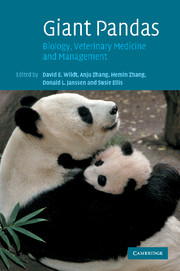Book contents
- Frontmatter
- Contents
- List of contributors
- Foreword
- Acknowledgements
- 1 The giant panda as a social, biological and conservation phenomenon
- 2 The Giant Panda Biomedical Survey: how it began and the value of people working together across cultures and disciplines
- 3 Factors limiting reproductive success in the giant panda as revealed by a Biomedical Survey
- 4 Significant medical issues and biological reference values for giant pandas from the Biomedical Survey
- 5 Life histories and behavioural traits as predictors of breeding status
- 6 Nutrition and dietary husbandry
- 7 Male reproductive biology in giant pandas in breeding programmes in China
- 8 Endocrinology of the giant panda and application of hormone technology to species management
- 9 The value and significance of vaginal cytology
- 10 Parentage assessment among captive giant pandas in China
- 11 The science of behavioural management: creating biologically relevant living environments in captivity
- 12 Evaluating stress and well-being in the giant panda: a system for monitoring
- 13 The neonatal giant panda: hand-rearing and medical management
- 14 Consequences of early rearing on socialization and social competence of the giant panda
- 15 Medical management of captive adult and geriatric giant pandas
- 16 Diseases and pathology of giant pandas
- 17 Ultrasonography to assess and enhance health and reproduction in the giant panda
- 18 Gastrointestinal endoscopy in the giant panda
- 19 Historical perspective of breeding giant pandas ex situ in China and high priorities for the future
- 20 Role and efficiency of artificial insemination and genome resource banking
- 21 Analysis of demographic and genetic trends for developing a captive breeding masterplan for the giant panda
- 22 Partnerships and capacity building for securing giant pandas ex situ and in situ: how zoos are contributing to conservation
- Index
- Plate Section
- References
17 - Ultrasonography to assess and enhance health and reproduction in the giant panda
Published online by Cambridge University Press: 09 August 2009
- Frontmatter
- Contents
- List of contributors
- Foreword
- Acknowledgements
- 1 The giant panda as a social, biological and conservation phenomenon
- 2 The Giant Panda Biomedical Survey: how it began and the value of people working together across cultures and disciplines
- 3 Factors limiting reproductive success in the giant panda as revealed by a Biomedical Survey
- 4 Significant medical issues and biological reference values for giant pandas from the Biomedical Survey
- 5 Life histories and behavioural traits as predictors of breeding status
- 6 Nutrition and dietary husbandry
- 7 Male reproductive biology in giant pandas in breeding programmes in China
- 8 Endocrinology of the giant panda and application of hormone technology to species management
- 9 The value and significance of vaginal cytology
- 10 Parentage assessment among captive giant pandas in China
- 11 The science of behavioural management: creating biologically relevant living environments in captivity
- 12 Evaluating stress and well-being in the giant panda: a system for monitoring
- 13 The neonatal giant panda: hand-rearing and medical management
- 14 Consequences of early rearing on socialization and social competence of the giant panda
- 15 Medical management of captive adult and geriatric giant pandas
- 16 Diseases and pathology of giant pandas
- 17 Ultrasonography to assess and enhance health and reproduction in the giant panda
- 18 Gastrointestinal endoscopy in the giant panda
- 19 Historical perspective of breeding giant pandas ex situ in China and high priorities for the future
- 20 Role and efficiency of artificial insemination and genome resource banking
- 21 Analysis of demographic and genetic trends for developing a captive breeding masterplan for the giant panda
- 22 Partnerships and capacity building for securing giant pandas ex situ and in situ: how zoos are contributing to conservation
- Index
- Plate Section
- References
Summary
INTRODUCTION
Ultrasonography is a routine diagnostic procedure used for assessing soft tissue characteristics in the human and veterinary medical fields of ophthalmology, cardiology, neurology, nephrology, obstetrics, oncology and orthopaedics. Because various forms of ultrasonography have existed for more than 50 years, it is surprising that this technology has only recently been applied to the study and management of wildlife species (Hildebrandt & Göritz, 1998; Hildebrandt et al., 2003). Nonetheless, there already is enough evidence making it clear that ultrasonography, combined with other technologies, can address issues that directly impact the health and reproductive welfare of wildlife species. This chapter focuses on the relevance of this technique for assisting in the assessment of medical and reproductive health in the giant panda.
The struggle to propagate and maintain viable wild animal populations in captivity is often related to information gaps that limit our ability to develop breeding and health strategies that are species appropriate. As demonstrated throughout this book, the giant panda presents some significant challenges to ex situ managers, which are exacerbated by a lack of basic biological knowledge about the species. Ultrasonographical studies are helping fill these physiological and anatomical voids by allowing the:
characterisation of reproductive tract morphology;
description of reproductive events;
monitoring of foetal development;
documentation of progression and treatment of pathologies.
Ultrasonography is also playing a significant role in developing and using artificial insemination (AI), which plays a critical role in the genetic management of this species (see Chapters 20 and 21).
- Type
- Chapter
- Information
- Giant PandasBiology, Veterinary Medicine and Management, pp. 410 - 439Publisher: Cambridge University PressPrint publication year: 2006
References
- 4
- Cited by



